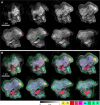Multimodal x-ray and electron microscopy of the Allende meteorite
- PMID: 31555739
- PMCID: PMC6754224
- DOI: 10.1126/sciadv.aax3009
Multimodal x-ray and electron microscopy of the Allende meteorite
Abstract
Multimodal microscopy that combines complementary nanoscale imaging techniques is critical for extracting comprehensive chemical, structural, and functional information, particularly for heterogeneous samples. X-ray microscopy can achieve high-resolution imaging of bulk materials with chemical, magnetic, electronic, and bond orientation contrast, while electron microscopy provides atomic-scale spatial resolution with quantitative elemental composition. Here, we combine x-ray ptychography and scanning transmission x-ray spectromicroscopy with three-dimensional energy-dispersive spectroscopy and electron tomography to perform structural and chemical mapping of an Allende meteorite particle with 15-nm spatial resolution. We use textural and quantitative elemental information to infer the mineral composition and discuss potential processes that occurred before or after accretion. We anticipate that correlative x-ray and electron microscopy overcome the limitations of individual imaging modalities and open up a route to future multiscale nondestructive microscopies of complex functional materials and biological systems.
Figures




References
-
- Miao J., Ishikawa T., Robinson I. K., Murnane M., Beyond crystallography: Diffractive imaging using coherent x-ray light sources. Science 348, 530–535 (2015). - PubMed
-
- Pfeiffer F., X-ray ptychography. Nat. Photonics 12, 9–17 (2018).
-
- Falcone R., Jacobsen C., Kirz J., Marchesini S., Shapiro D., Spence J., New directions in X-ray microscopy. Contemp. Phys. 52, 293–318 (2011).
-
- Hitchcock A. P., Soft X-ray spectromicroscopy and ptychography. J. Electron Spectrosc. Relat. Phenom. 200, 49–63 (2015).
-
- Miao J., Charalambous P., Kirz J., Sayre D., Extending the methodology of X-ray crystallography to allow imaging of micrometre-sized non-crystalline specimens. Nature 400, 342–344 (1999).
Publication types
Grants and funding
LinkOut - more resources
Full Text Sources
Molecular Biology Databases

